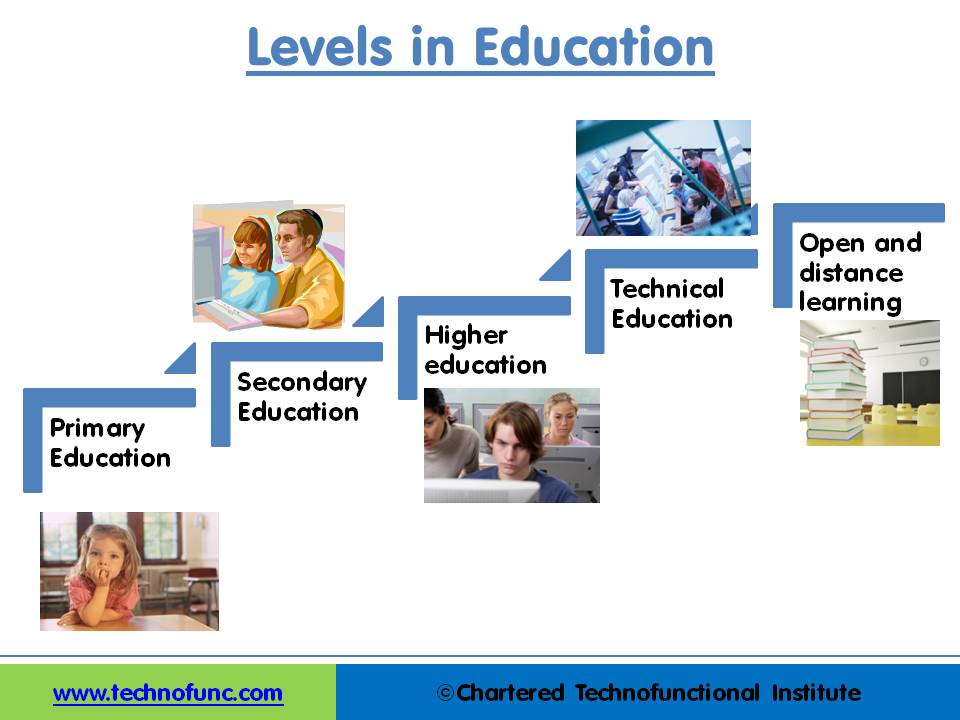- Home
- Business Processes
- Industry Knowledge
- Aerospace Industry
- Automotive Industry
- Banking Domain
- BFSI Industry
- Consumer/ FMCG Industry
- Chemicals Industry
- Engineering & Construction
- Energy Industry
- Education Domain
- Finance Domain
- Hospitality Domain
- Healthcare Industry
- Insurance Domain
- Retail Industry
- Travel and Tourism Domain
- Telecom Industry
- Leadership Skills
- eLearning
- Home
- Domain Knowledge
- Education Domain
- Levels in Education Industry
Levels in Education Industry
Different governments and different standards classify levels of education differently. There is a difference in nomenclature that is in practice today. However, for the purpose of simplicity, all classifications can be mapped to the grid provided in this article. Given below are commonly used different levels in the education process.
Different governments and different standards classify levels of education differently. There is a difference in nomenclature that is in practice today. However, for the purpose of simplicity, all classifications can be mapped to the following grid. Given below are commonly used different levels in the education process. For a more standard classification, the reader can refer to “The International Standard Classification of Education (ISCED)” which is an instrument for compiling internationally comparable education statistics. The current version covers two classification variables: levels and fields of education as well as general/vocational/prevocational orientation and educational/labor market destination.
Levels in Education:
Level 1: Pre-Primary Education
This is the initial stage of organized instruction; it is school or center-based and is designed for children aged at least three years. Also referred to as Kindergarten and currently, most kindergartens are private-run. Public kindergartens are usually affiliated to primary schools. Pupils aged four to six are admitted for 1-2 years of schooling.
Level 2: Primary/Elementary Education:
Elementary or primary education is the first type of formal education most people encounter. Primary education begins between five and seven years of age, is the start of compulsory education where it exists, and generally covers six years of full-time schooling. This is actually the first level in the Education ladder. The importance of primary education is recognized as it lays the foundation for lifelong learning. It has been found that the child develops significantly in physical, cognitive, social, and emotional aspects in the early years, and its experiences deeply influence its disposition for learning. Primary schools develop basic skills and social behavior by games, exercises, music, and simple handicrafts.
The seven foundation learning areas of primary education are thinking, communicating, sense of self and others, health and physical understanding, social living and learning, cultural understanding, and understanding the environments. They teach basic literacy skills such as reading and writing, as well as mathematics, history, science, and many other topics. To graduate, students are required to pass standardized testing that meets applicable regulatory or funding requirements.
Level 3: Secondary Education:
Secondary education is the stage of education following primary education. Secondary level education is like a bridge between elementary and higher education. It prepares young students between the age group of 12 and 18 for entry into higher education. The main focus of the curriculum at this level is to prepare students for employment, give instruction functional academics, and teach them adaptive skills. The social and interpersonal skills are developed during this phase of education.
Lower Secondary Education – continues the basic programs of the primary level, although teaching is typically more subject-focused. Usually, the end of this level coincides with the end of compulsory education.
Upper Secondary Education – generally begins at the end of compulsory education. The entrance age is typically 15 or 16 years. Entrance qualifications (end of compulsory education) and other minimum entry requirements are usually needed. Instruction is often more subject-oriented and the typical duration varies from two to five years.

Level 4: Tertiary Education:
Colleges, universities, and polytechnics are the main institutions that provide tertiary education (sometimes known collectively as tertiary institutions). Tertiary education generally culminates in the receipt of certificates, diplomas, or academic degrees. In tertiary education, analytical skills take precedence over the ability to memorize. Tertiary studies can also lead to an advanced research qualification (Ph.D. or doctorate).
Level 5: Higher Education:
Higher, post-secondary, tertiary, or third level education refers to the stage of learning that occurs at universities, academies, colleges, seminaries, and institutes of technology. Higher education also includes certain collegiate-level institutions, such as vocational schools, trade schools, and career colleges that award academic degrees or professional certifications. Higher education includes teaching, research, exacting applied for work (e.g. in medical schools and dental schools), and social services activities of universities.
Higher education follows secondary education. Students take academic courses and are awarded undergraduate, masters, and doctorate degrees. Higher education facilities may also offer professional degrees – for instance, law, medicine, or dentistry degrees. Typical examples are programs designed to prepare pupils for doctorate studies or programs designed to prepare pupils for direct labor market entry.
Level 6: Technical/Vocational Education:
Technical education, as the term suggests, is different from regular education. Its ambit primarily comprises training and research programs in sectors like engineering, technology, architecture, town planning, management, pharmacy, applied arts and crafts, hotel management and catering technology, etc. Facilities that offer vocational education provide training that allows students to obtain work in technical and trade professions – computer programming or plumbing, for instance. This includes tertiary programs with an academic orientation which are largely theoretical and tertiary programs with an occupational orientation. The latter are typically shorter and aimed at preparing students for the employment market.
Related Links
You May Also Like
-
How to Improve Education System
The education industry today is faced with many challenges, and in order to improve the education system and the performance and development of the education industry, the major improvement must be made in the sector. This article discusses the major components that need to be worked upon to create an effective improvement strategy.
-
Challenges in Education System
The Education sector underwent some major changes over the past five years. Enrolment in private schools outpaced government school enrolment for much of the period. Tutoring businesses and universities have offered new services to expand their market base. Online education is a major development for the Education Division, and technology is permeating all areas of education. Understand some of the major challenges that are faced by the education sector today.
-
What drives the Education Industry
In the section, we will discuss the drivers of the education industry. Business drivers are influences, both internal and external, that significantly impact the direction of an industry. This will help the learner understand the internal and external factors that have a significant influence on the education industry.
-
Different governments and different standards classify levels of education differently. There is a difference in nomenclature that is in practice today. However, for the purpose of simplicity, all classifications can be mapped to the grid provided in this article. Given below are commonly used different levels in the education process.
-
The education industry is expanding rapidly and its many businesses are eager for new talent, including experienced professionals and enthusiastic individuals just entering the workforce. The education industry can be described as the collection of organizations and businesses that provide products and services aimed at enhancing the quality of education in society. Read more to gain a complete overview of the education industry.
-
Importance of Education Industry
Nelson Mandela has said, “Education is the most powerful weapon which you can use to change the world.” The following article touches on some aspects that highlight the importance of education industry for human society.
-
History of Education & Its Growth as an Industry
Education in its general sense is a form of learning in which knowledge, skills, and habits of a group of people are transferred from one generation to the next through teaching, training, research, or simply through autodidacticism. This article takes you through the history of education and its development as an industry.
-
The education industry is divided up into four sectors, which all have their own roles and functions. Each of the sectors caters to a growing demand for cutting-edge education products and services. Each category has distinct market segments, all of which are defined in this article below. For learners to understand the dynamics of the education industry, having a clear picture of the industry is crucial. This understanding will help in researching education companies, determining a career path, and even exploring potential employers.
Explore Our Free Training Articles or
Sign Up to Start With Our eLearning Courses

About Us
Learning
© 2023 TechnoFunc, All Rights Reserved








